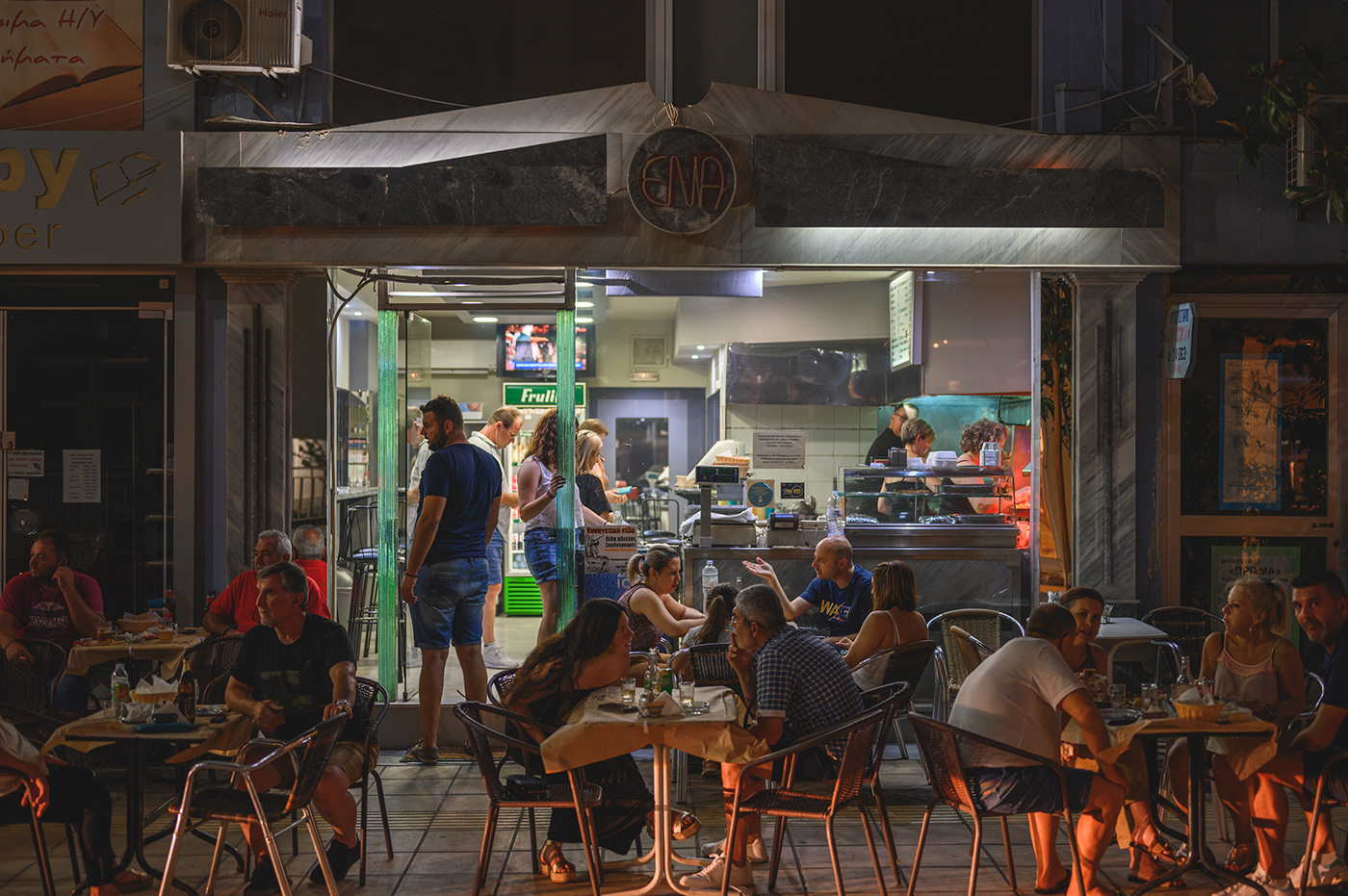
Almyrós 4.0
Small-town life after the Greek financial collapse
Almyrós, Greece—July 2019
Almyrós is a small town of around 10,000 residents near the western coast of the Pagasetic Gulf. It is the capital of the province of Almyrós, part of the Magnesías region in Thessaly, Greece. Located in the centre of the Krókio Pedío (Krókio Plain), it is the main agricultural centre of Magnesías, with fertile lands producing cotton, wheat, tomatoes, almonds, peanuts, pistachios, olives, grapes, apples and honey.
For a short time during my early childhood, Almyrós—which means ‘salty’ in Greek—was my hometown. My grandmother was born in Makríno, a small village northeast of Ioánnina and my grandfather in a village near Fársala now known as Vambakoú, about 50 kilometres northwest of Almyrós.
My grandmother’s brother bought land in Krókio, three kilometres north of Almyrós, around 1930 and, after she married my grandfather in 1938, they lived in a small house on her part of the land. An earthquake in 1954 damaged the house and it was rebuilt to be earthquake-resistant. This house has seen the births of my father and his brothers and sister, and the untimely death of my grandfather. My aunt and uncle live there to this day, my cousins were born and raised there, and my grandmother lived in the house until her death in 2009, aged 95.
Almyrós has its roots in nearby Álos, an important trading city in Ancient Greece dating back to more than 500 BC and, according to Ancient Greek historian Herodotus, one of the places King Xerxes I stayed during the Greco-Persian Wars.
Álos was destroyed during the Third Sacred War in 346 BC, re-founded in 302 BC, abandoned in the mid-3rd century following what some historians believe was a major earthquake, and then relocated to its present location, due to pirate raids during the fall of the Byzantine Empire—Almyrós 1.0.
In 1311 Almyrós was the site of the Battle of Halmyros, a particularly bloody battle that resulted in the conquest of the Duchy of Athens. By the mid 1800s, the town was primarily inhabited by the Turks with some 300 homes and by the late 1800s, as the Ottoman Empire declined, Almyrós was once again reclaimed, repopulated and redeveloped by the Greeks—Alymirós 2.0.
In 1980, much of Almyrós was destroyed by a magnitude 6.5 earthquake which left 24 people injured and nearly 20,000 buildings in the greater area destroyed or seriously damaged.
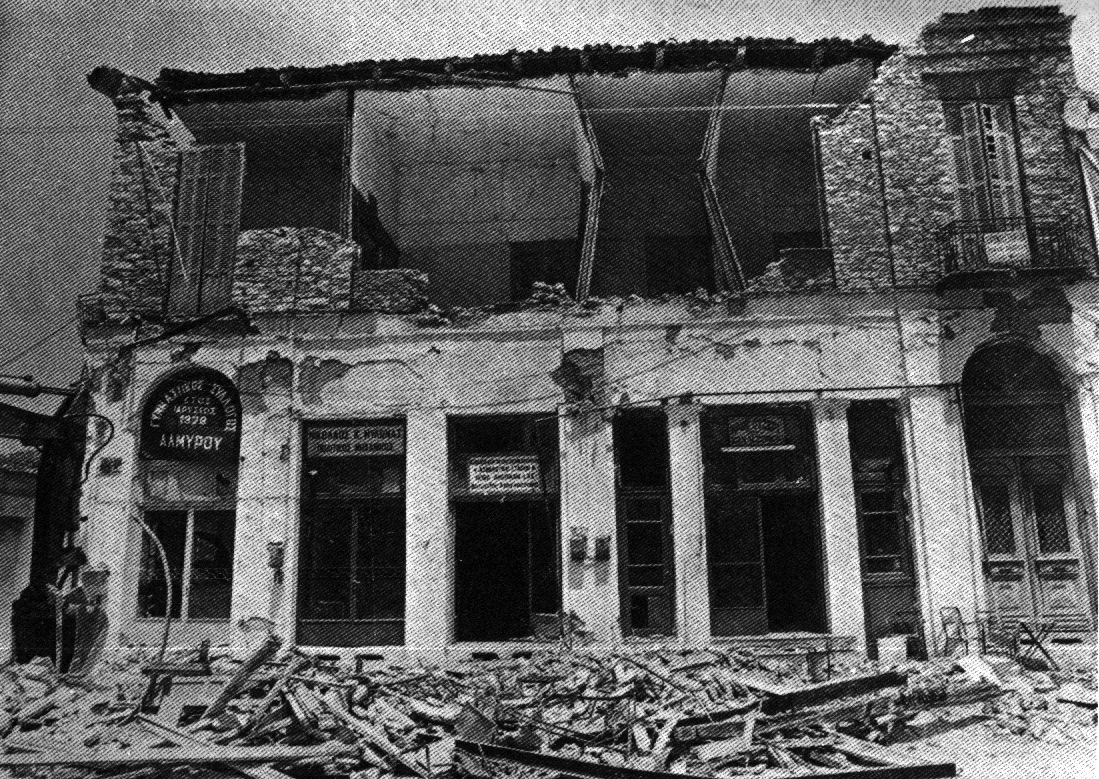

Aftermath of the magnitude 6.5 earthquake on 9 July 1980 (photos: ΟΑΣΠ, the Greek Earthquake Planning and Protection Organisation)
With such a colourful history spanning thousands of years, Almyrós is no stranger to finding its feet after crisis. In the years following the earthquake, despite the Greek economic depression of the 1980s, the town was slowly rebuilt—Alymirós 3.0.
The subsequent election of a socially liberal government resulted in a large increase in government spending—businesses grew and thrived, and the ermoú (high street) was packed every day with shoppers visiting locally-owned, one-off shops selling everything from cleaning supplies to clothes to perfumes and leather goods. People now had money and they were keen to spend it.
Under the surface, however, the government was getting into more and more debt, the extent of which was somewhat masked when Greece adopted the Euro in 2001 and their lending rates dropped. The strong currency ‘plastered over’ the deep-rooted, severe economic issues that the country was experiencing.
People became complacent about saving and thinking about the future, with a mentality of spend what money you have today, because there will always be more tomorrow. The taverns and coffee shops were full at all hours, every day of the week—often until 3 or 4 in the morning. Some people were taking early retirement from their civil servant jobs while others were using up every one of their paid sick days, regardless of their health.
Largely in part to the global financial crisis in 2008, by early 2009 the Greek economy crashed when the country’s debt became unviable. Greece found itself in a position where it didn’t have the money to pay the interest on its loans, let alone the principal. It was, in fact, so severe that Greece defaulting on its debt threatened the viability of the Eurozone itself—and so the EU stepped in to bail out Greece, starting a drawn-out ordeal which continues to this day.
As part of the bailout, Greece introduced austerity measures, known as mnimónio, the Greek word for memorandum—effectively a series of pay cuts, job losses and tax increases to generate income for the government to repay the bailout. The first round was issued in 2009.
In the years before the crisis, low-interest loans and mortgages, including interest-only mortgages, were easily obtainable with minimal downpayment—with this temptation, many people bought property and cars beyond their means. The mnimónio was based on people’s property size and, for a time, utility usage. Road tax increased, particularly for cars with larger engines. Many people found themselves owing money to the government that they could not repay.
People were devastated—even previously middle class families were finding themselves with no disposable income and losing their property. This led to the collapse of the real estate market, as no one could sell larger homes. Shops failed and closed—with no disposable income, the shoppers who once came in droves were now focused on keeping roofs over their families’ heads.

A house sits empty outside Almyrós—the owner now lives elsewhere but visits from time to time to carry out basic maintenance
Two more rounds of mnimónio have been issued since 2009, introducing further austerity measures including a 10% increase in VAT rates.
Around 500,000 skilled and educated Greeks, or roughly 4% of the country’s population, had enough and jumped ship over the past decade—surgeons, nurses, midwives, dentists, professors, architects, accountants, lawyers—to take up better pay and lower taxes elsewhere in the EU. These higher earners were the ones hit hardest, and so their loss greatly reduces the amount of income the government can claw back, further compounding the country’s financial issues.
Walking along the ermoú in Almyrós during the day, the area feels abandoned with around 80% of the shops sitting empty, their signs slowly fading in the sun and buildings showing signs of neglect—a few still have window displays in place, untouched for years, thick with dust.
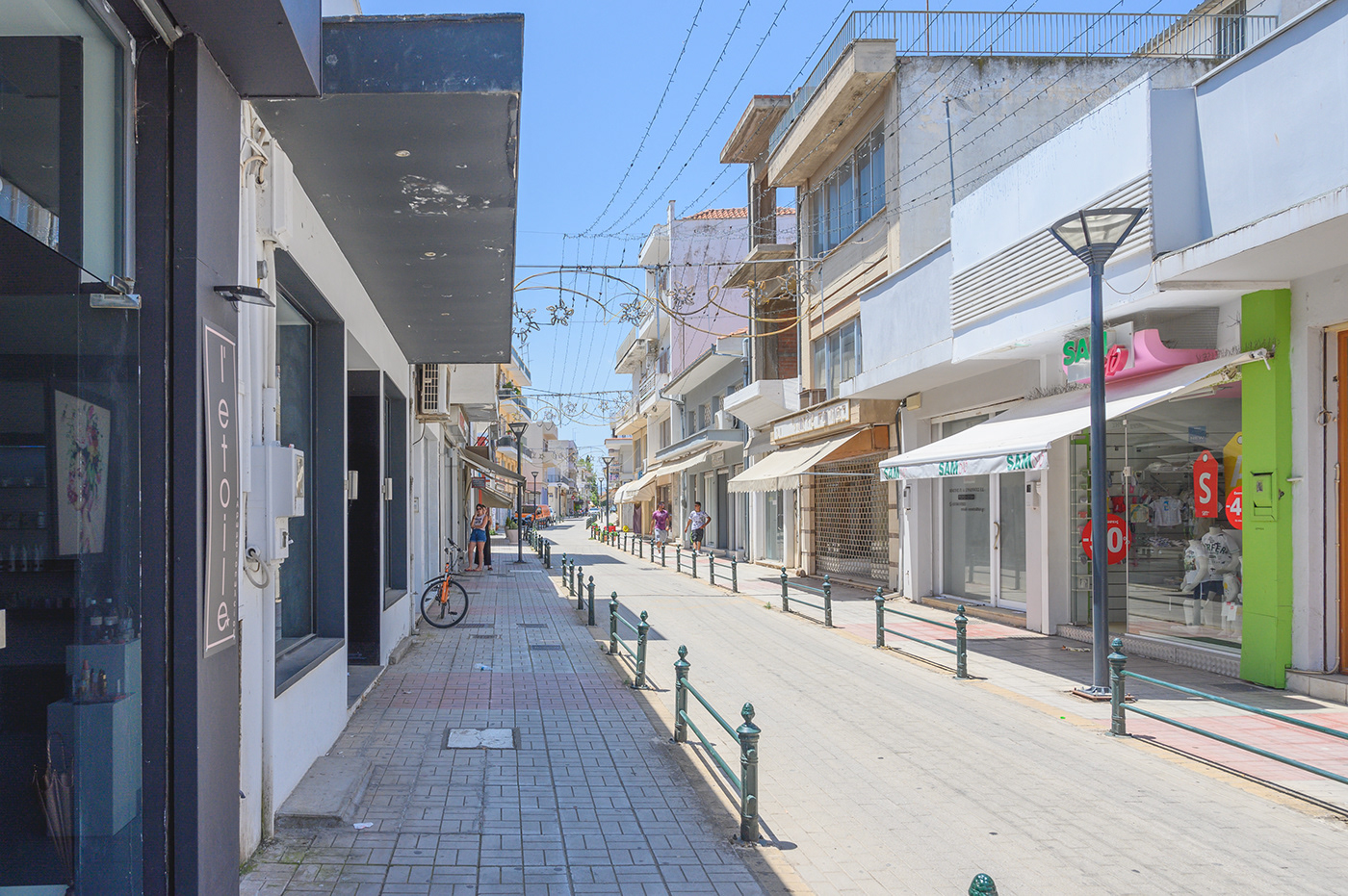

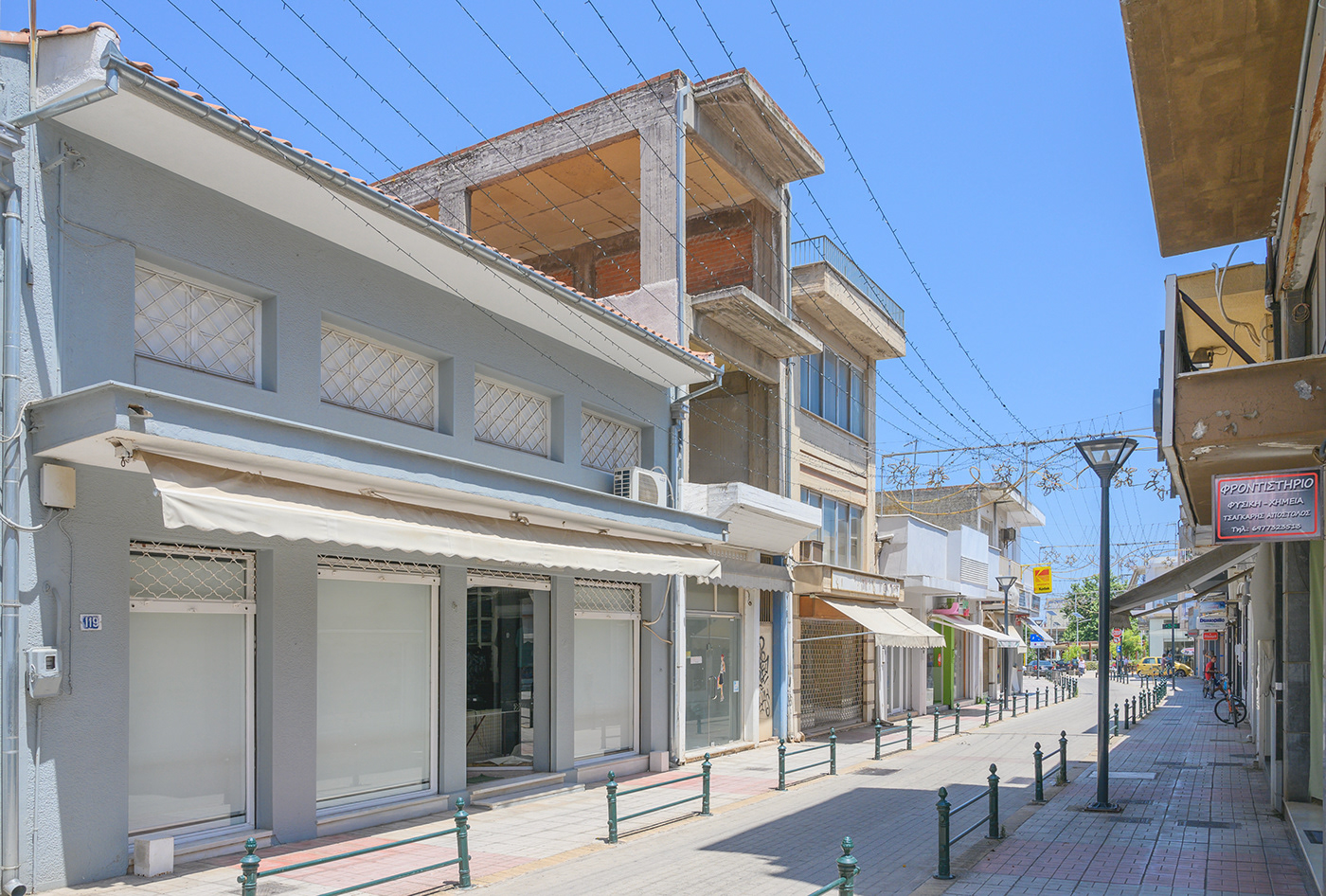
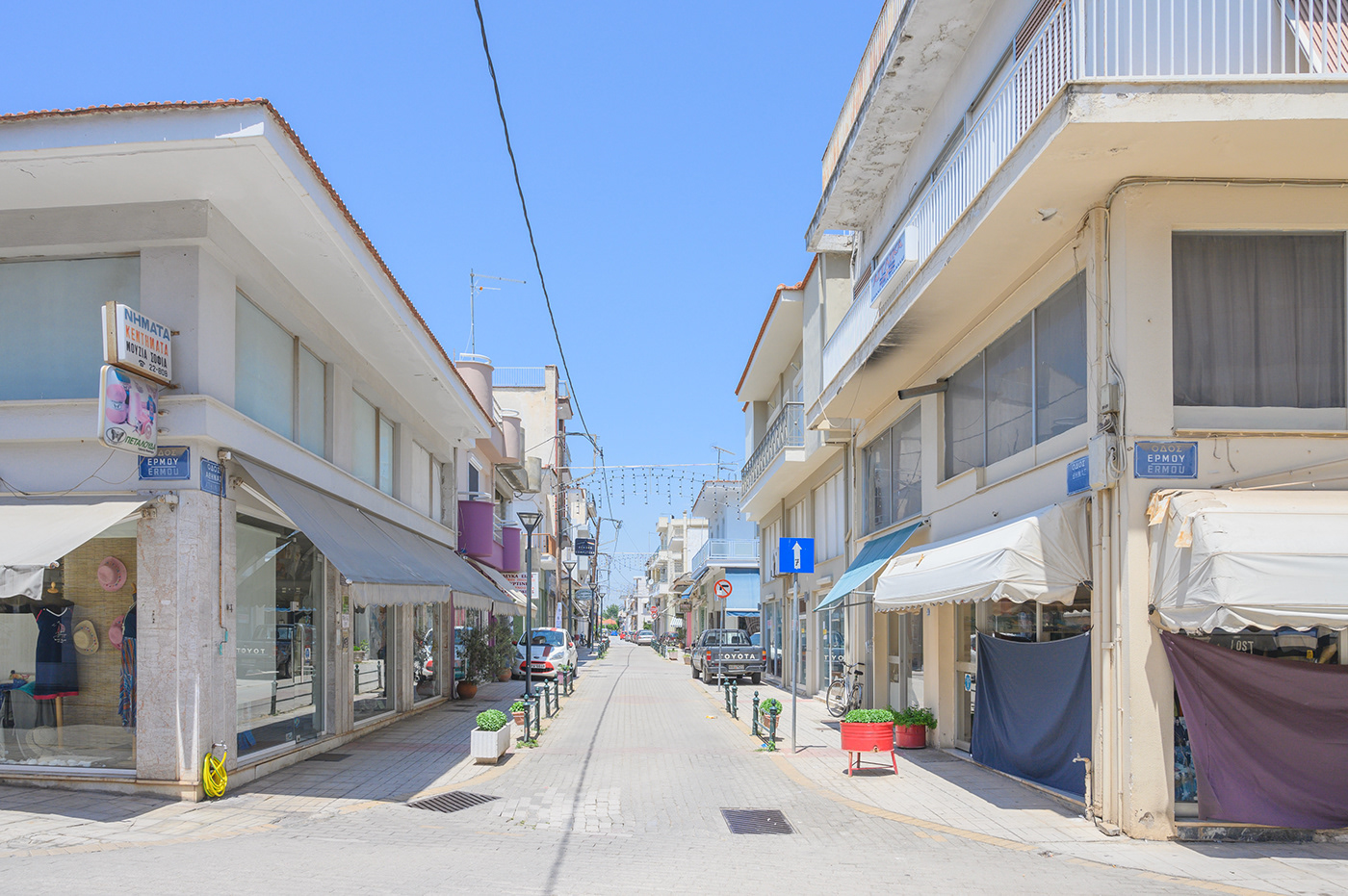



Abandoned businesses on the ermoú
Some of the shops that have managed to stay open advertise discounts in their windows in an effort stimulate sufficient sales to stay afloat. Others have branched out in unique ways, such as one shop which sells bicycles and pet supplies.

A shop selling bicycles and pet supplies
Approaching the town square, there are fewer abandoned buildings—a positive sign that the economy is slowly recovering. On the roads coming off the square are a handful of shops selling sportswear, cosmetics, shoes, lingerie and photography equipment, as well as a pharmacy.



A few open shops near the town square
One of my cousins runs a small, very pink aromatopoleío (perfumery) and is doing well for herself. Her father is a renowned sign maker in Almyrós and most of the hand-painted signs around town, including hers, are his work. As children, my cousins and I used to help out by painting in the letters on festival banners, but much of this work has been superseded by desktop publishing software and large format printers today.

My cousin’s perfumery
Around the town square are a number of zacharoplasteía (sweet/pastry shops) and kafetéries (coffee shops) with ‘barbas’ (old men/grandpas) gossiping out front, restaurants, mobile phone shops, corner shops and banks. One building looms over the west side of the square, half-built and frozen in time for more than a decade—a sobering reminder of how the money ran out when the crisis hit.
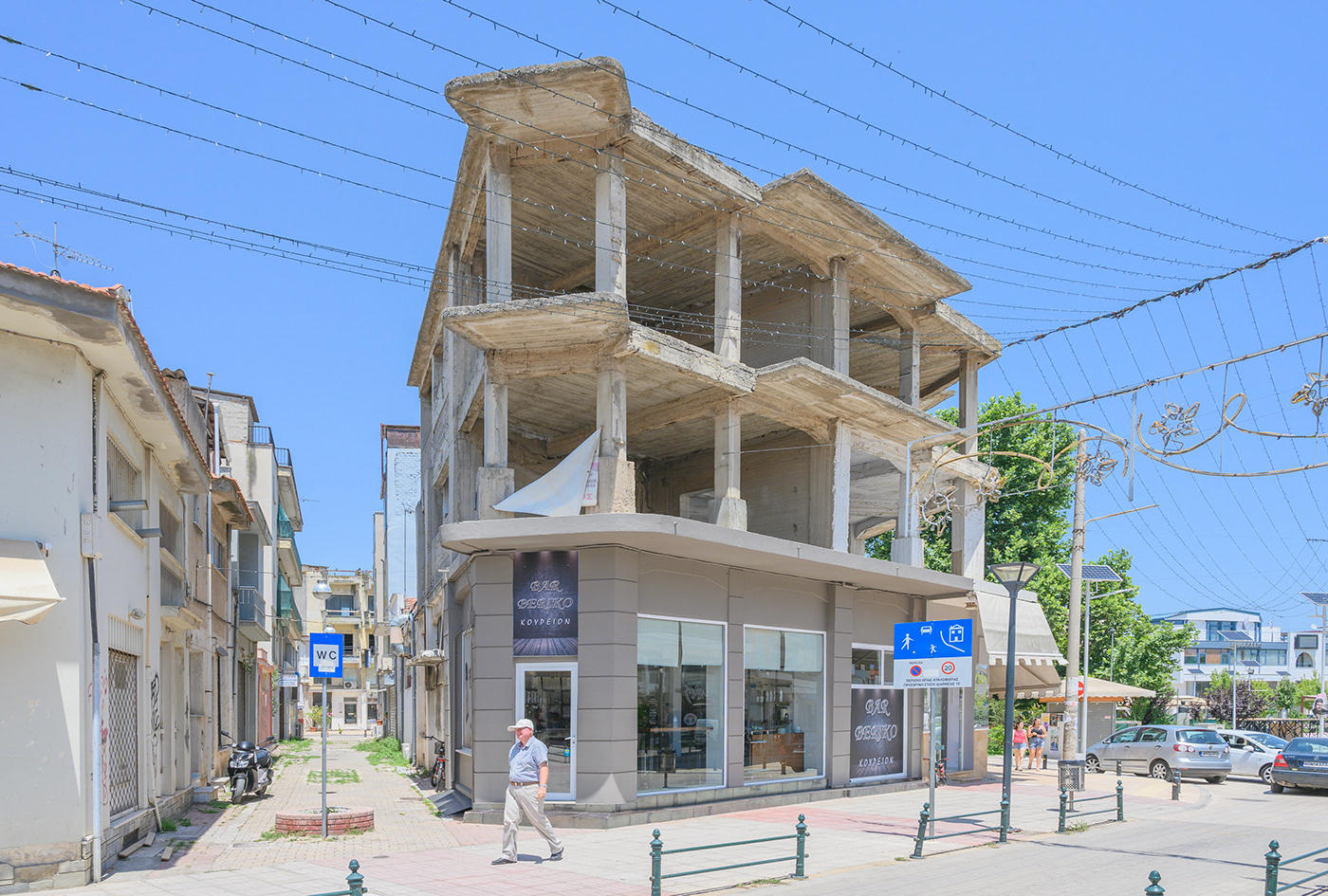
An unfinished building looms over the west side of the square

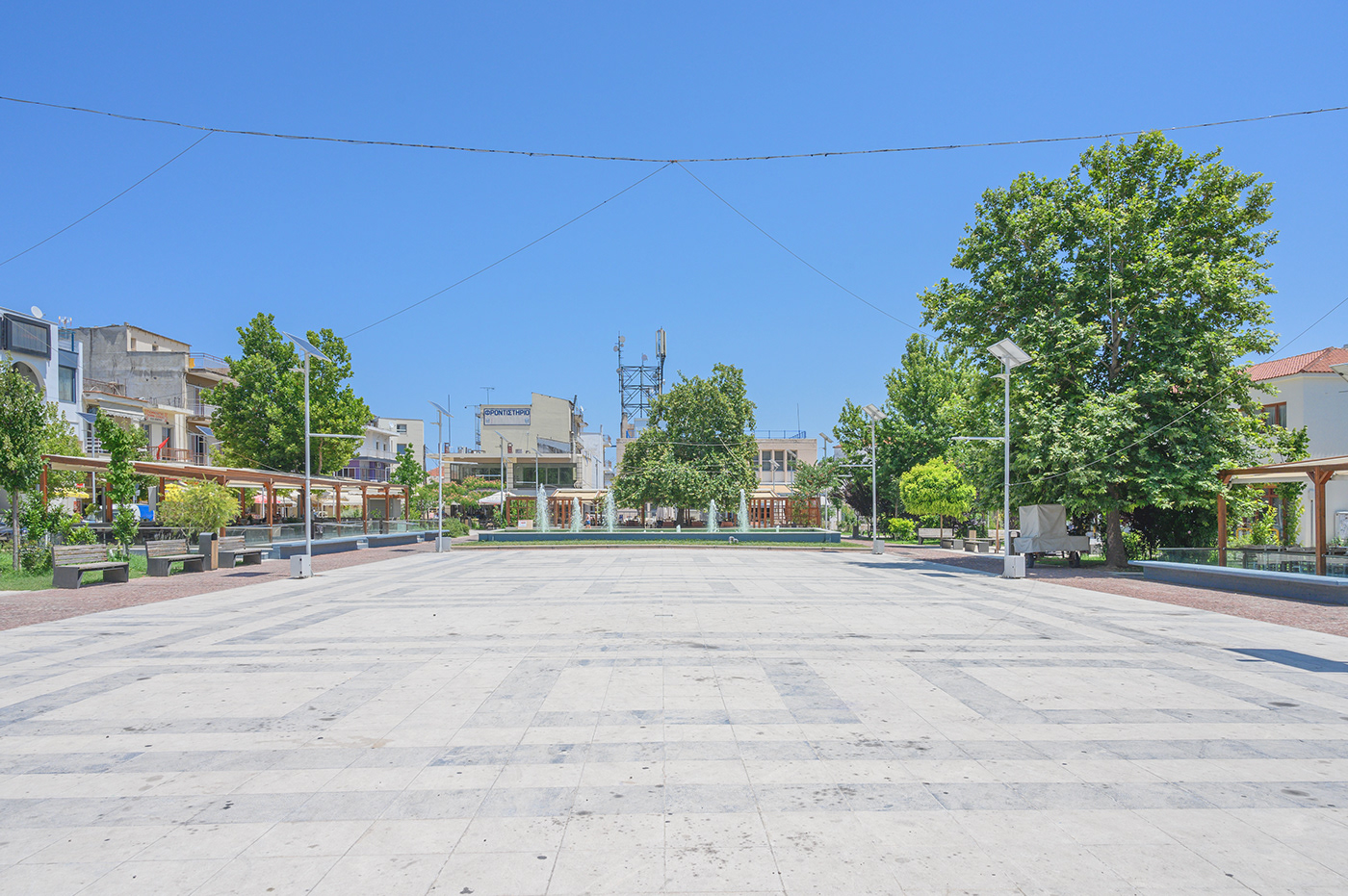
The Almyrós town square
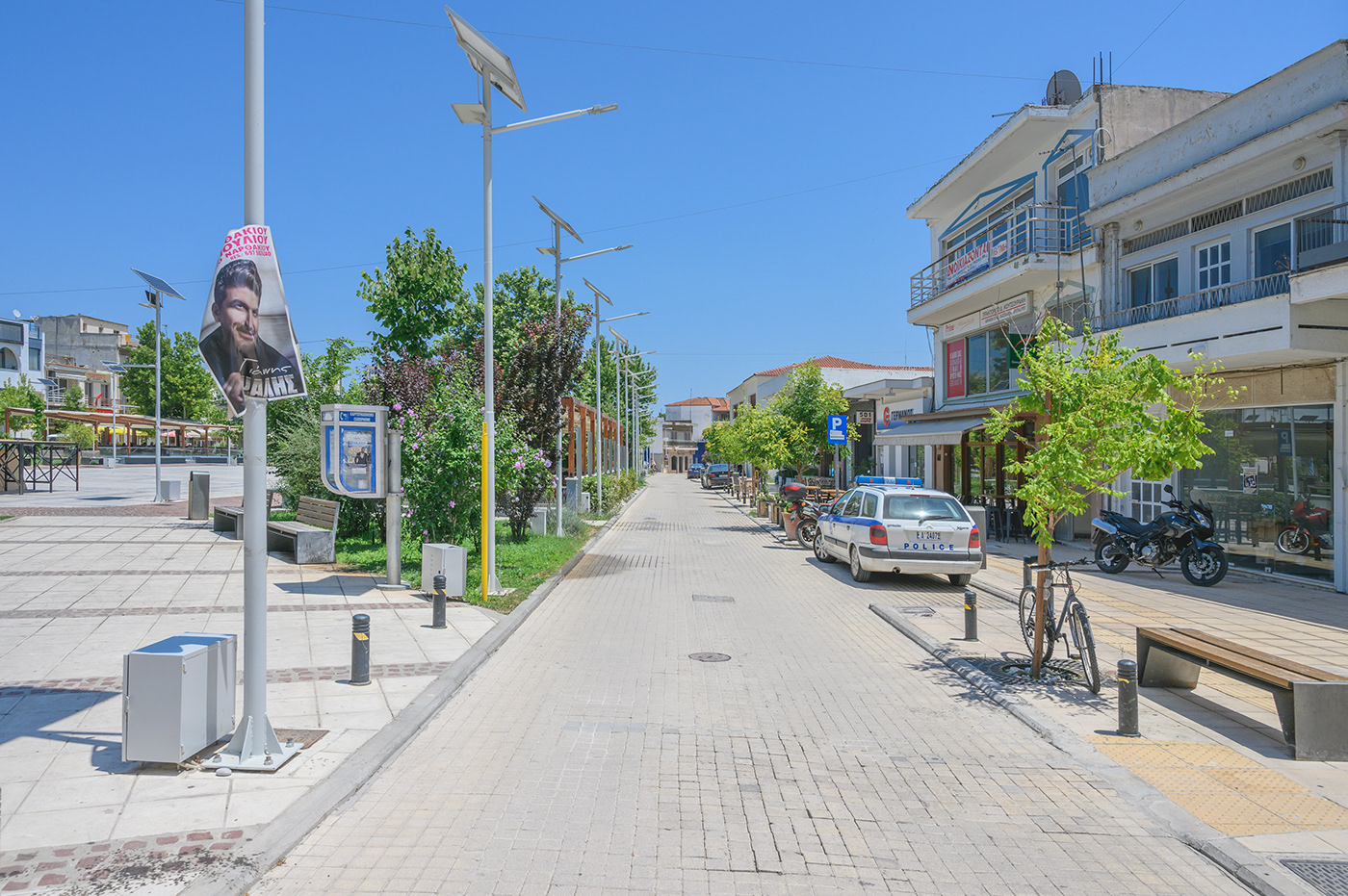
The road beside the town square—a poster advertises an upcoming festival
Almyrós suffered, but perhaps not to the extent of other areas in the country, as the local economy is supported by agriculture and people still need to eat. No one has been living on the streets—it’s a small, close community where people know and support each other. Some families sold (if they could) or abandoned their homes and moved into their parents’ homes. Others brought food to neighbours who had it worse.
At nighttime, however, the town square comes alive, as people head out to socialise and have a bite to eat. Walking past a local gyro shop in 36°C (97°F) heat at nearly 11:30pm, the place is hopping—somehow the heat is tolerable and everyone is just getting on with it. Places like this offer good quality gyros—chewy Greek flatbreads filled with spit-roasted meat, tomatoes, onions, chips, mustard and tzatzíki—for €2.40, or €3 with a fizzy drink. Just one is plenty for dinner.
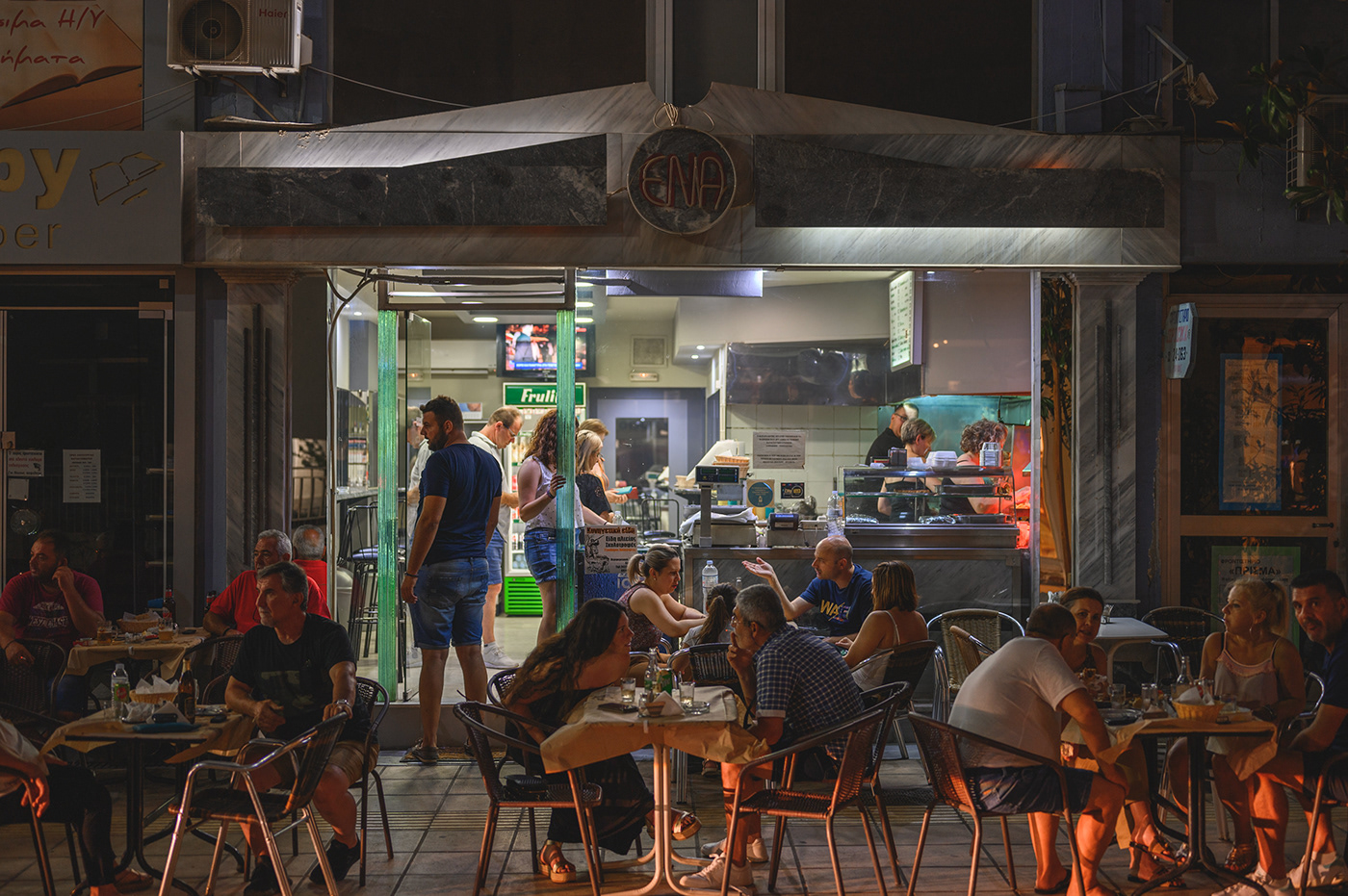
Locals socialise and enjoy late night meals at a busy gyro shop
Compared to the feeling of a ghost town during the day, nighttime is a world away—people are dressed up and enjoying themselves. Prices in the local bars and restaurants reflect the crisis—as a Londoner accustomed to London’s obscene, eye-watering prices, I found food and drink in rural Greece to be shockingly inexpensive. The Greeks may be loathe to admit it, but euros from outside the country are more important than ever to Greece’s future.


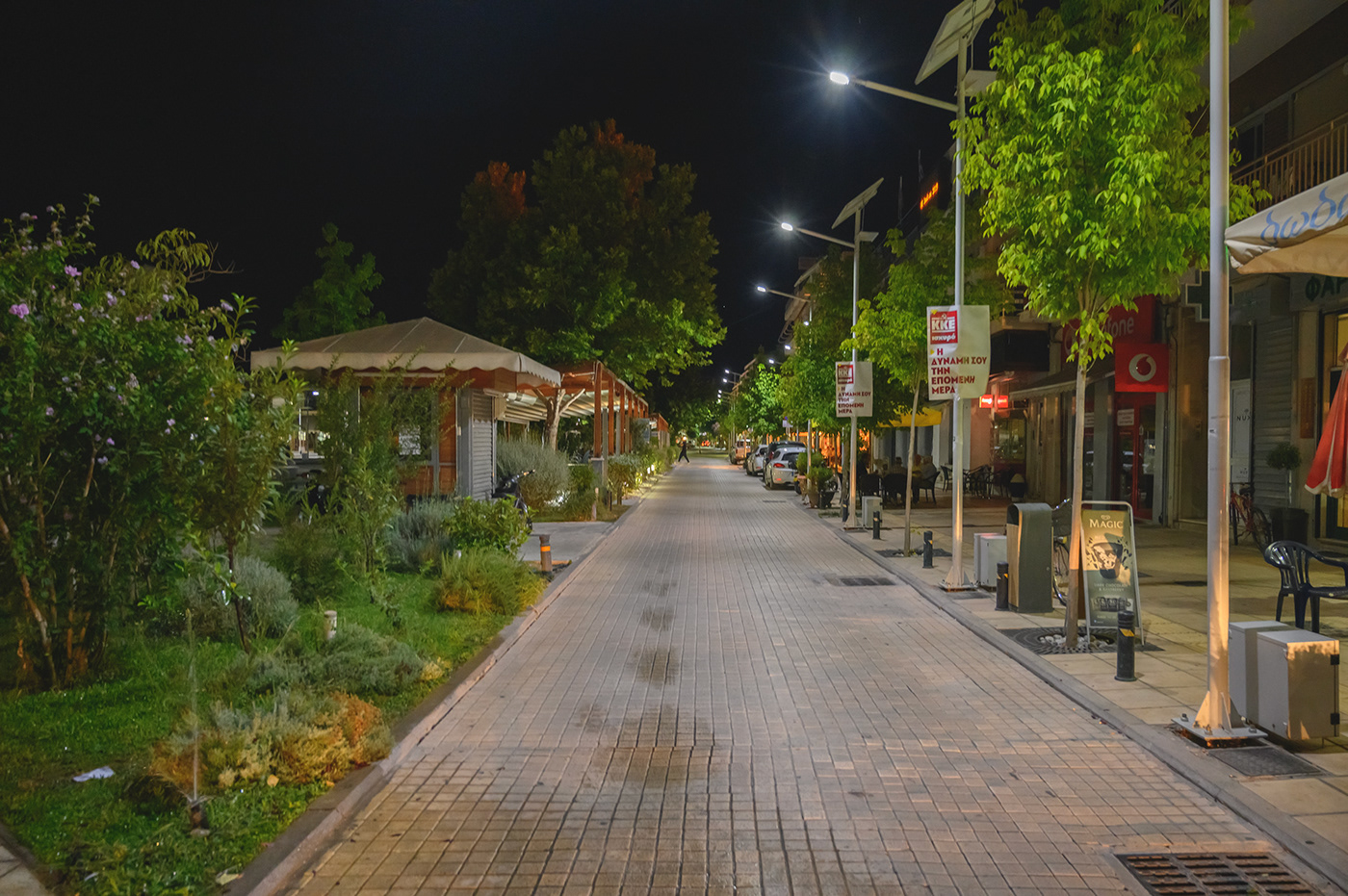
The venues around the Almyrós town square come alive at night
The town square itself was once packed during the evenings, as vólta, or walking the square, was the primary way people would meet and socialise—a piece of Greek culture lost because of cheap mobile broadband, smartphones and social media. Now it’s mainly a place for kids to play.

Kids playing ball and hanging out in the Almyrós town square
Not ten minutes after the photo above, storm clouds rolled in and the lightning started. Five minutes later it was like a monsoon. This is typical of the area—a couple of fast, hard storms each summer, soaking the dry earth briefly before dissipating.

The sky lights up during a sudden midsummer storm
With Almyrós slowly coming out of its slumber a decade on, and shops re-opening further and further out from the town square, the ermoú is likely to thrive again but, for now, it’s baby steps—Almyrós 4.0.
Life goes on, though, crisis or not—15 kilometres away in the beach town of Néa Anchíalos, the taverns along the boardwalk and pebble beach are full every night with people eating, drinking and taking in the stunning views of the gulf.
Typically the taverns offer little 50ml bottles of ouzo with a bucket of ice and a glass for €7–10. So much for so little, you may be thinking. But each order of ouzo comes with four mezze—go out in a group of four and for €30–40 you get 16 mezze. Plus a tipple. Mezze can include anything from simply fried fresh sardines, cuttlefish and spinach stew, dolmáthes (stuffed vine leaves), to fried saganáki cheese, hummus, vegetable stew and even stuffed peppers. After you’ve finished, it’s quite common for the waiter to bring out the kérasma—a complimentary small dessert such as a scoop of ice cream or a mini panna cotta. You don’t leave hungry.
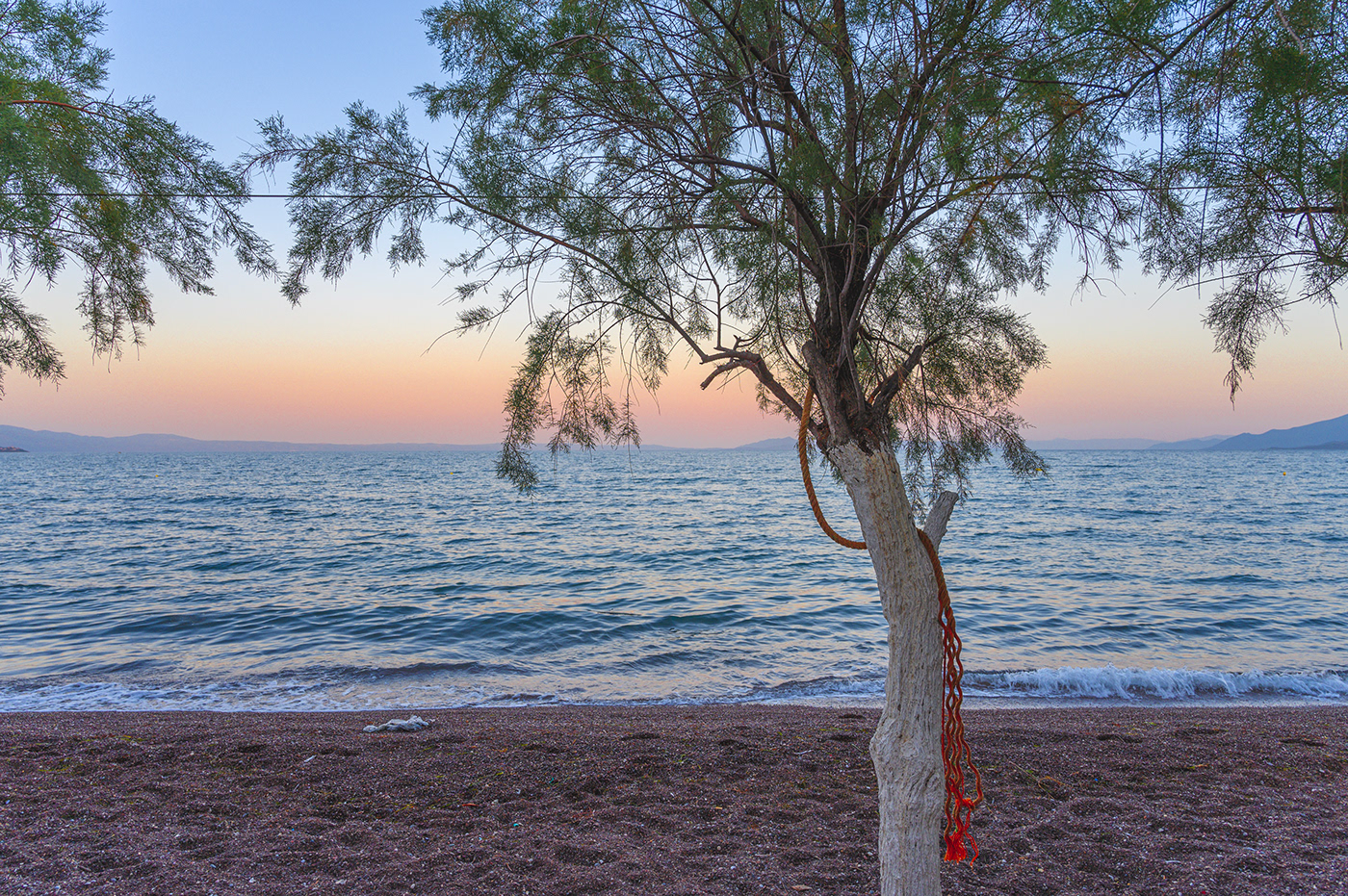
Néa Anchíalos beach at sunset
Further along the gulf in Velanidiá, young Harry plays on his grandparents’ veranda, naïve to the financial struggles affecting the country. His father Giánnis is a hairdresser—one of the industries that has tempered the crisis particularly well (people still want to look and feel good)—and internationally-recognised athlete in events including the Xterra Championship, Panhellenic Open Sea Championship and numerous marathons, triathlons and cycling challenges around Europe.
Fifty metres away is the village beach, with its sparkling turquoise waters, where Harry often goes with his father or his mother Emi.


Three-year-old Harry enjoys throwing around a beach ball on his grandparents’ veranda

The village beach in Velanidiá
My parents Freda and Ioánnis enjoy their retirement by living the simple life just outside Almyrós for a few months each year—happiness is not dependent on material items, and the crisis has caused a lot of Greeks to look at their own lives through fresh eyes, prioritising family and health.

Freda and Ioánnis relax on their patio
Freda and Ioánnis visiting with Sophía and Geórgios—their friends of more than 40 years.

Sophía, Freda, Ioánnis and Geórgios
Over the last decade, the once common riots and demonstrations in major Greek cities have trailed off as the Greeks have come to a realisation that they cannot survive unless big changes are made. Greeks are a stubborn bunch, and giving up the luxuries they once had is a hard pill to swallow for many.
Greece was once the height of civilisation—the birthplace of democracy and also, ironically, where drama and tragedy originate—but the unfortunate truth is that in modern times it has offered little on a world scale.
Greece needs to search its soul to find its essence and innovation once again—it can no longer survive on olives and feta alone.

Thank you
A huge thank you to my mum’s friend Jennifer who agreed to be interviewed and kindly offered her firsthand perspective of living in Greece throughout the crisis.
Footnote
Writing, photography (except where noted) and post-production by George Vasilopoulos

